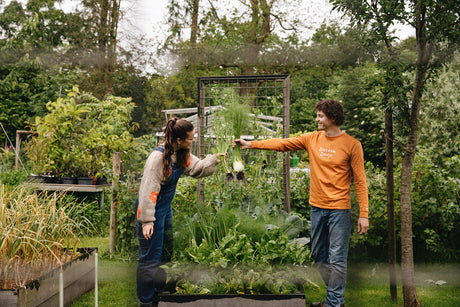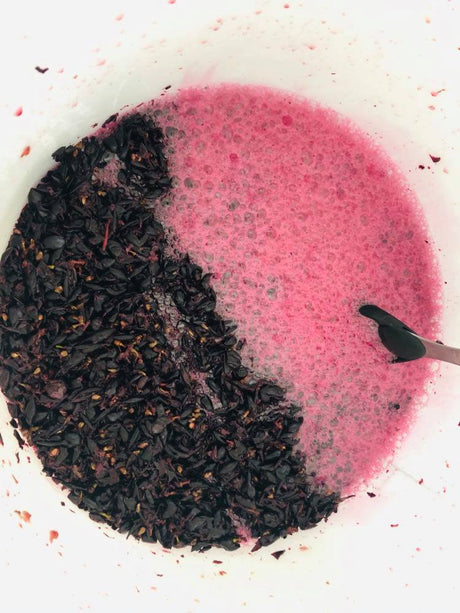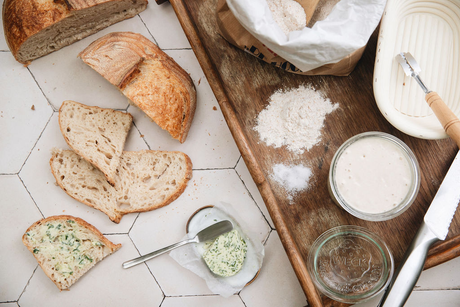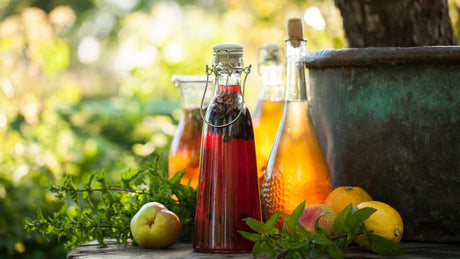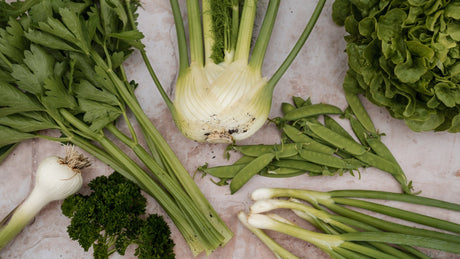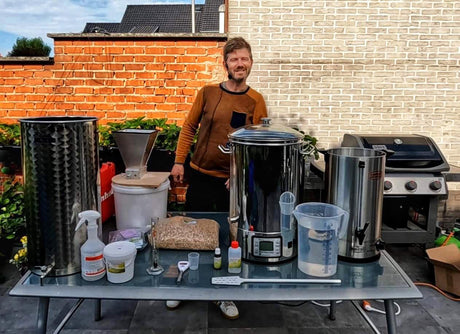A dry vegetable garden, what now?
The barrels empty, no irrigation system or water connection, checking the rain radar in vain, global warming (read: dehydration), ... It's that time again, we have a dry vegetable garden. In my village, only 23.2 mm fell in the last two months of April and May. In 2016, that was 85.7 mm. The years before that were similar. After the complaining and nagging about too little rain, I started looking for other solutions. Solutions that we do have influence on, unfortunately the climate cannot be lectured. There are regions in the world where it is even drier than here. And they also do agriculture there. I collected the following tips.

Drought in the vegetable garden
Dry farming - dry vegetable gardening
Dry farming (I call it dry gardening for convenience) is a strategy for agriculture and horticulture where rain and (ground)water are scarce. By definition, dry gardening is growing vegetables without watering in a climate that only has 50 mm or less of rainfall per year. That is never the case with us, but the techniques that are applied can help us in the drier months.

Dry farming in Morocco
Drought versus dry conditions in the vegetable garden
Vegetables and other crops need water to germinate, grow and produce fruit. Plants also absorb nutrients through water. We speak of drought when plants are unable to absorb water. This is not the same as dry conditions. If you live in a dry region or if the water locks in your region remain closed, you can certainly still enjoy a productive vegetable garden.
Dry gardening is not gardening without water, it is growing crops with limited amounts of water and getting the most out of little water.

Collect rain in the vegetable garden
Objectives of dry gardening
Before you start your vegetable garden season, set some goals for growing vegetables in dry conditions.
- Catch every raindrop you can.
- Choose crops or varieties that can survive in dry conditions.
- Increase your sowing distances, fewer vegetables per m2 is better in dry conditions.
- Avoid evaporation of the water that is abundantly available after the winter months.

Mulching in a dry vegetable garden
Dry vegetable garden tips or tips for dry vegetable gardens
These are some simple practical examples to achieve your dry garden goals above.
- Add organic matter to your garden. Tarred compost or manure. The more the better. Add at least 1 cm of tarred compost or manure twice a year. Once in early spring and once in autumn. With 1 big bag of 1 cubic meter (1000 liters or 15 bags of 60 liters) of compost , you can provide a vegetable garden of 50 m² with 1 cm twice. Buy a good weed-free compost . The compost from waste processing companies is often full of seeds . You know what happens when weeds germinate ... they take water from the soil.
- Apply a layer of mulch around your crops. It keeps the moisture in the soil and acts as an insulator. The temperature fluctuations in the restaurant of your vegetable garden (where your plants eat) remain pleasantly constant. You can mulch with tarred (weed-free) compost , straw (without ears with grain because they also germinate), leaves, grass, newspaper, cardboard, ... If you use compost , make sure you do not use it right next to the trunks of plants, your trunks can rot. Mulch will also protect your vegetable garden soil from dry wind and the burning sun.
- Keep your garden weed free. Weeds compete with your vegetables for soil water, nutrients and light. Remove weeds by hand when they are 5 to 8 cm high and before they really take a lot of water, light and food from your vegetables. You can also hoe. This works the soil superficially and exposes the roots of the weeds and they die off. Dead weeds are also a form of mulch , you can certainly leave them there. Never allow weeds to sow and multiply themselves. Your back will thank you.

Regularly till your garden superficially
- Work your vegetable garden soil superficially, loose soil absorbs moisture faster than caked or flushed soil. If you use mulch , you kill this fly in the face. Well-worked soil absorbs up to 70% of the water during rainfall. Also work 5 to 8 cm deep after each period of rain.
- Work your vegetable garden soil with a spading fork every year. This way you loosen the top 25 cm of your soil well and more moisture is stored deep in the soil until your plants need it. In loose soil you give vegetables the chance to create a deeper root system and to absorb moisture more easily. Never turn your soil if your soil is too wet or too dry, a good time is autumn. The weeds will not grow back quickly then because the temperatures drop. You can add your layer of compost (see above) on top.
- We all want to get as many vegetables as possible from our garden. But with sandy soil that dries out quickly or little water available, you would do well to take the sowing and planting distances a little wider. If you multiply the planting and sowing distances from the crop sheets on our site by 1.5, you will harvest more in a dry vegetable garden than if you don't. With fewer plants, the water also stays in the soil longer, which is good news for the vegetables that you will harvest. What good are 100 carrots the size of a little finger when you can harvest 50 nice thick carrots .
- Plant early varieties or choose an early crop. There is more moisture in the soil early in the year. For example, plant more early potatoes than late potatoes . Or choose a widow's crop of cauliflower . All crops per crop can be found above via the 'Crops' button. Sow indoors where you have more access to water. In my videos about How to sow with Buzzy Seeds and Horti Tops, I often get the comment: "I sow that directly". With all due respect, but in my sandbox I can currently sow very little. Or I had to stand next to it with a watering can (#exaggeration).
- Grow mini or dwarf varieties. For tomatoes ' Tiny Tim ' in pots or the 'Iznik' snack cucumber , or carrots 'Paris Market'. Smaller vegetables also means smaller leaves, smaller fruits and therefore less water absorption. Often a large cucumber is drying out in the fridge, especially if you only have a small family. Harvest your vegetables earlier. I harvest my broccoli when they are the size of a large orange. You have more flavor and when there is too little moisture they will bolt prematurely.
- If you sow, thin out a little earlier in your dry vegetable garden. In ideal conditions, you thin out onions, lettuce or carrots when you can already eat them (as spring onion , spring lettuce or as young carrots ), but with a dry vegetable garden, it is better to do it earlier. Let the strong seedlings grow through very quickly, see it as weeding, whereby you prevent other plants from stealing the water from under the noses of the vegetables.
- Don't harvest too late but at the peak of the vegetable or even a little before. This way the plant doesn't continue to absorb water while the taste and texture decreases. Leave some water for a follow-up crop .
- If available, use a drip irrigation system, it works very well and gives your plants water gradually. Thicken your drip system with straw to prevent evaporation. Use a timer and adjust the flow rate according to the needs of your vegetable garden.
- Better to water once thoroughly than a little bit every day. Plant roots follow the water. Water your dry vegetable garden deeply with a fine spray nozzle, so the water seeps deep and does not run off on your lightly tilled soil. Water the base of your plants in the morning. If you are afraid that you will wet the stem or the leaves, do it in the evening, then your plants have enough time to dry out before night falls. And also not to burn in the scorching sun.
- Catch as much water as possible. On the garden shed or chicken run and make compost tea. You can make compost tea by mixing equal amounts of water and compost with old, tarred compost . Compost tea is a nutrient-rich substance that is immediately absorbed by the plants, unlike organic fertilizer pellets. Remember, plants drink their food.
- Protect your dry vegetable garden with a natural windbreak, so your garden dries out less quickly. This can be a hedge or a fence. You can also use sunflower and or Jerusalem artichoke. Some also use root cloth.
- For people with a small vegetable garden this is not an option but leaving your land fallow for a year without crops on it can bring your water level back up. This is also a technique used in dry gardening in combination with mulch .
So, instead of complaining too much about the lack of rain, I used my time to look for information and tips about gardening in a dry vegetable garden. That way I will be a little better prepared for next year.
Greetings Tom
 Drought in the vegetable garden
Drought in the vegetable garden Dry farming in Morocco
Dry farming in Morocco Collect rain in the vegetable garden
Collect rain in the vegetable garden Mulching in a dry vegetable garden
Mulching in a dry vegetable garden Regularly till your garden superficially
Regularly till your garden superficially Amsterdamse bak is an early variety and can therefore be harvested quickly
Amsterdamse bak is an early variety and can therefore be harvested quickly

